Answered step by step
Verified Expert Solution
Question
1 Approved Answer
Southeastern Homecare was founded in 1992 in Miami, Florida, as a taxable partnership by Maria Gonzalez, MD; Ramon Garcia, RN; and Ron Sparks, LPT. Its
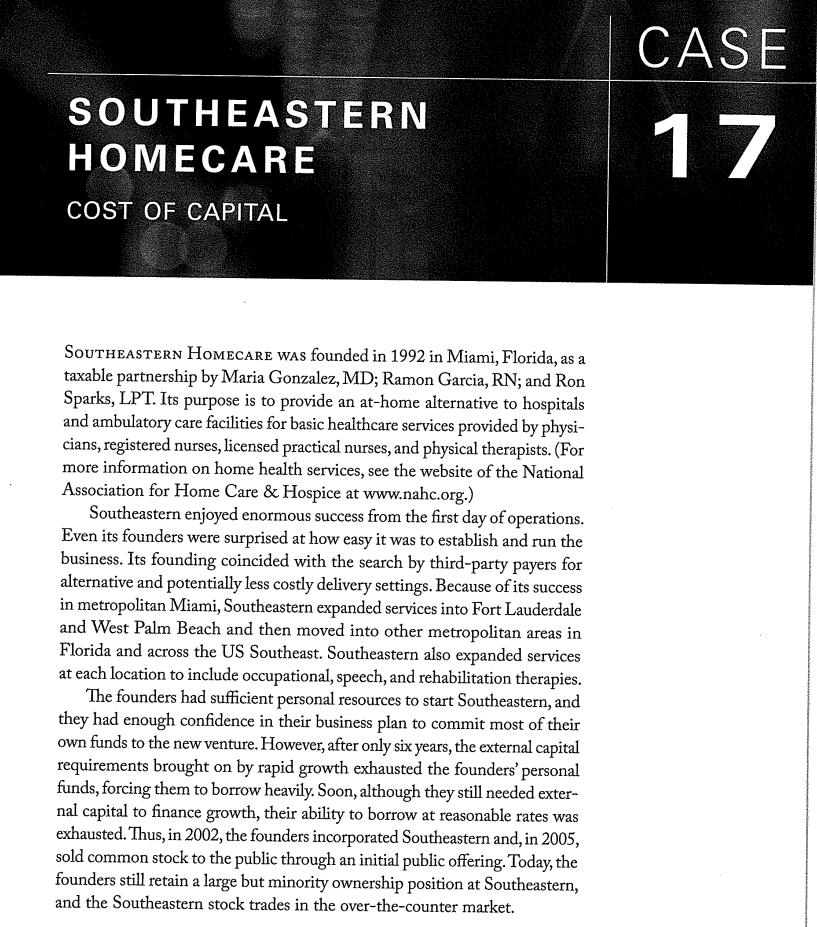
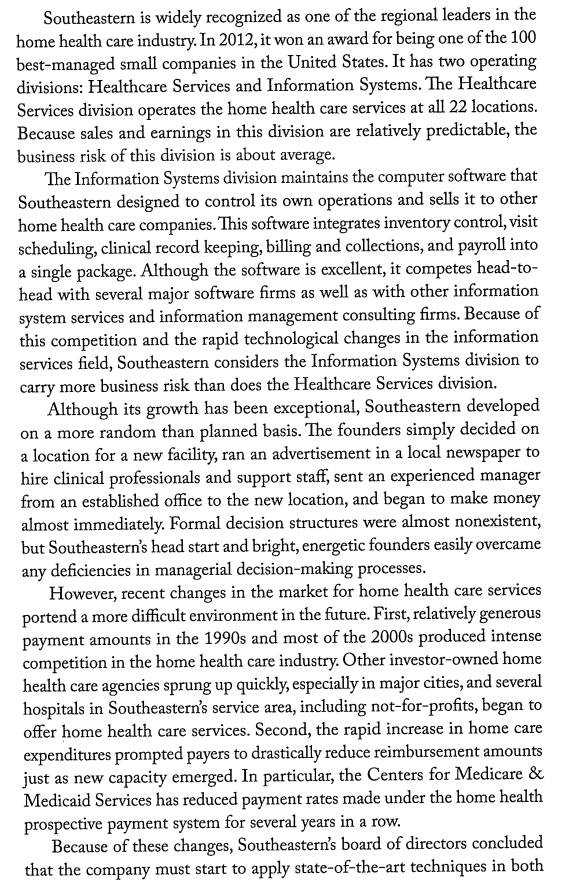
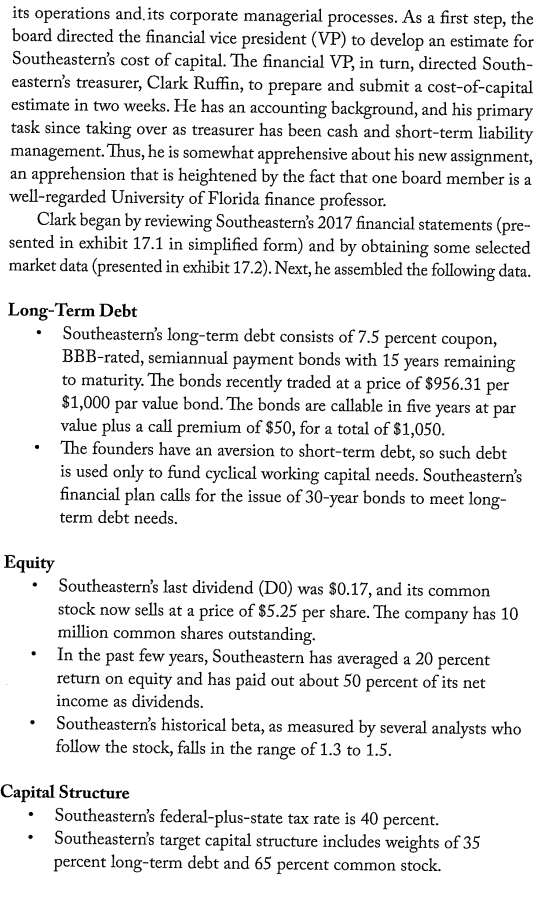


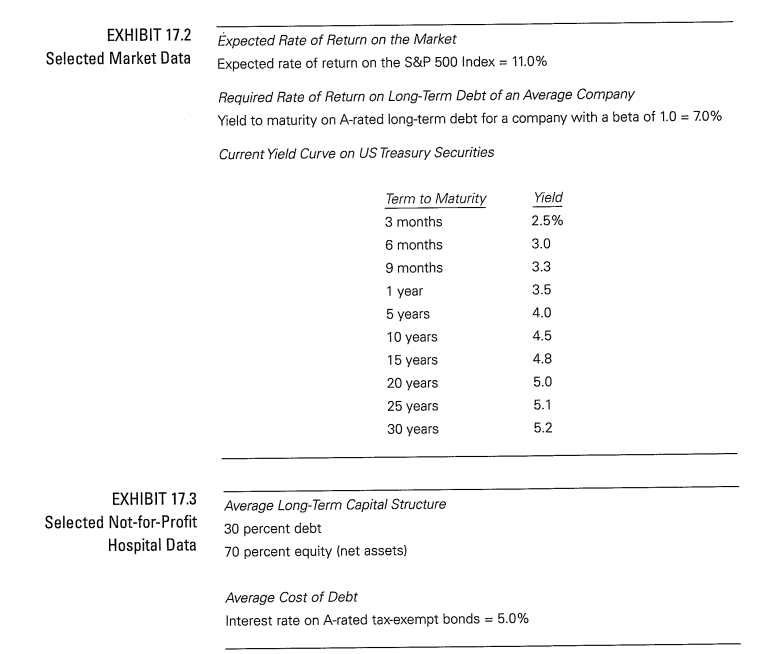
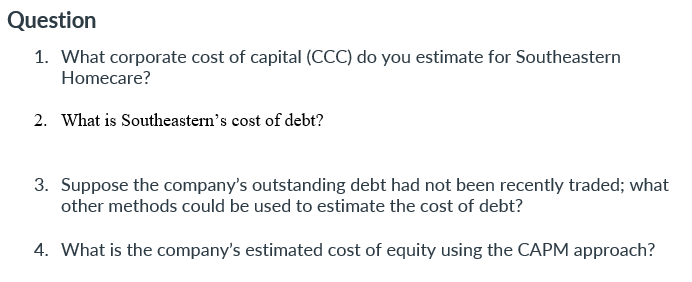 Southeastern Homecare was founded in 1992 in Miami, Florida, as a taxable partnership by Maria Gonzalez, MD; Ramon Garcia, RN; and Ron Sparks, LPT. Its purpose is to provide an at-home alternative to hospitals and ambulatory care facilities for basic healthcare services provided by physicians, registered nurses, licensed practical nurses, and physical therapists. (For more information on home health services, see the website of the National Association for Home Care \& Hospice at www.nahc.org.) Southeastern enjoyed enormous success from the first day of operations. Even its founders were surprised at how easy it was to establish and run the business. Its founding coincided with the search by third-party payers for alternative and potentially less costly delivery settings. Because of its success in metropolitan Miami, Southeastern expanded services into Fort Lauderdale and West Palm Beach and then moved into other metropolitan areas in Florida and across the US Southeast. Southeastern also expanded services at each location to include occupational, speech, and rehabilitation therapies. The founders had sufficient personal resources to start Southeastern, and they had enough confidence in their business plan to commit most of their own funds to the new venture. However, after only six years, the external capital requirements brought on by rapid growth exhausted the founders' personal funds, forcing them to borrow heavily. Soon, although they still needed external capital to finance growth, their ability to borrow at reasonable rates was exhausted. Thus, in 2002, the founders incorporated Southeastern and, in 2005, sold common stock to the public through an initial public offering. Today, the founders still retain a large but minority ownership position at Southeastern, and the Southeastern stock trades in the over-the-counter market. Southeastern is widely recognized as one of the regional leaders in the home health care industry. In 2012, it won an award for being one of the 100 best-managed small companies in the United States. It has two operating divisions: Healthcare Services and Information Systems. The Healthcare Services division operates the home health care services at all 22 locations. Because sales and earnings in this division are relatively predictable, the business risk of this division is about average. The Information Systems division maintains the computer software that Southeastern designed to control its own operations and sells it to other home health care companies. This software integrates inventory control, visit scheduling, clinical record keeping, billing and collections, and payroll into a single package. Although the software is excellent, it competes head-tohead with several major software firms as well as with other information system services and information management consulting firms. Because of this competition and the rapid technological changes in the information services field, Southeastern considers the Information Systems division to carry more business risk than does the Healthcare Services division. Although its growth has been exceptional, Southeastern developed on a more random than planned basis. The founders simply decided on a location for a new facility, ran an advertisement in a local newspaper to hire clinical professionals and support staff, sent an experienced manager from an established office to the new location, and began to make money almost immediately. Formal decision structures were almost nonexistent, but Southeastern's head start and bright, energetic founders easily overcame any deficiencies in managerial decision-making processes. However, recent changes in the market for home health care services portend a more difficult environment in the future. First, relatively generous payment amounts in the 1990 s and most of the 2000 s produced intense competition in the home health care industry. Other investor-owned home health care agencies sprung up quickly, especially in major cities, and several hospitals in Southeastern's service area, including not-for-profits, began to offer home health care services. Second, the rapid increase in home care expenditures prompted payers to drastically reduce reimbursement amounts just as new capacity emerged. In particular, the Centers for Medicare \& Medicaid Services has reduced payment rates made under the home health prospective payment system for several years in a row. Because of these changes, Southeastern's board of directors concluded that the company must start to apply state-of-the-art techniques in both its operations and.its corporate managerial processes. As a first step, the board directed the financial vice president (VP) to develop an estimate for Southeastern's cost of capital. The financial VP, in turn, directed Southeastern's treasurer, Clark Ruffin, to prepare and submit a cost-of-capital estimate in two weeks. He has an accounting background, and his primary task since taking over as treasurer has been cash and short-term liability management. Thus, he is somewhat apprehensive about his new assignment, an apprehension that is heightened by the fact that one board member is a well-regarded University of Florida finance professor. Clark began by reviewing Southeastern's 2017 financial statements (presented in exhibit 17.1 in simplified form) and by obtaining some selected market data (presented in exhibit 17.2). Next, he assembled the following data. Long-Term Debt - Southeastern's long-term debt consists of 7.5 percent coupon, BBB-rated, semiannual payment bonds with 15 years remaining to maturity. The bonds recently traded at a price of $956.31 per $1,000 par value bond. The bonds are callable in five years at par value plus a call premium of $50, for a total of $1,050. - The founders have an aversion to short-term debt, so such debt is used only to fund cyclical working capital needs. Southeastern's financial plan calls for the issue of 30-year bonds to meet longterm debt needs. Equity - Southeastern's last dividend (D0) was $0.17, and its common stock now sells at a price of $5.25 per share. The company has 10 million common shares outstanding. - In the past few years, Southeastern has averaged a 20 percent return on equity and has paid out about 50 percent of its net income as dividends. - Southeastern's historical beta, as measured by several analysts who follow the stock, falls in the range of 1.3 to 1.5 . Capital Structure - Southeastern's federal-plus-state tax rate is 40 percent. - Southeastern's target capital structure includes weights of 35 percent long-term debt and 65 percent common stock. Operating Divisions - About 60 percent of Southeastern's operating assets are used by the Healthcare Services division, and 40 percent by the Information Systems division. Management's best estimate of the Healthcare Services division's beta is 1.0. - Following are the two divisions' investment opportunities for next year: Clark has hired you as a consultant to develop Southeastern's overall corporate cost of capital. You will have to meet with the financial VPand possibly with the president and the full board of directors (including the founders and the finance professor) - to present your findings and answer any questions. In addition to performing a standard analysis, you must address several concerns raised at the last board meeting about the cost-of-capital estimate. First, the board chair noted that the corporate cost-of-capital estimate is influenced by several factors, some of which are external to the business. She is particularly interested in the impact on the estimated corporate cost of capital of factors that cannot be influenced by managerial actions. Second, the divisional presidents questioned why a single cost of capital will be applied across the company, regardless of any divisional risk differences. Clark has asked you to address this question by developing divisional costs of capital. Third, the founders alerted the group to the threat posed by home health care businesses started by not-for-profit hospitals, which have both cost (in the sense that they do not pay dividends) and tax advantages. To help assess this threat, Clark has asked you to estimate the cost of capital for an average not-for-profit hospital's home health care business, starting with the information in exhibit 17.3. Finally, one board director is worried about the difference between the target capital structure and the current structure as reported on the balance sheet. Clark wondered if this should be a matter for consideration. EXHIBIT 17.2 Selected Market Data Expected Rate of Return on the Market Expected rate of return on the S\&P 500 Index =11.0% Required Rate of Return on Long-Term Debt of an Average Company Yield to maturity on A-rated long-term debt for a company with a beta of 1.0=7.0% Current Yield Curve on US Treasury Securities EXHIBIT 17.3 Selected Not-for-Profit Hospital Data Question 1. What corporate cost of capital (CCC) do you estimate for Southeastern Homecare? 2. What is Southeastern's cost of debt? 3. Suppose the company's outstanding debt had not been recently traded; what other methods could be used to estimate the cost of debt? 4. What is the company's estimated cost of equity using the CAPM approach
Southeastern Homecare was founded in 1992 in Miami, Florida, as a taxable partnership by Maria Gonzalez, MD; Ramon Garcia, RN; and Ron Sparks, LPT. Its purpose is to provide an at-home alternative to hospitals and ambulatory care facilities for basic healthcare services provided by physicians, registered nurses, licensed practical nurses, and physical therapists. (For more information on home health services, see the website of the National Association for Home Care \& Hospice at www.nahc.org.) Southeastern enjoyed enormous success from the first day of operations. Even its founders were surprised at how easy it was to establish and run the business. Its founding coincided with the search by third-party payers for alternative and potentially less costly delivery settings. Because of its success in metropolitan Miami, Southeastern expanded services into Fort Lauderdale and West Palm Beach and then moved into other metropolitan areas in Florida and across the US Southeast. Southeastern also expanded services at each location to include occupational, speech, and rehabilitation therapies. The founders had sufficient personal resources to start Southeastern, and they had enough confidence in their business plan to commit most of their own funds to the new venture. However, after only six years, the external capital requirements brought on by rapid growth exhausted the founders' personal funds, forcing them to borrow heavily. Soon, although they still needed external capital to finance growth, their ability to borrow at reasonable rates was exhausted. Thus, in 2002, the founders incorporated Southeastern and, in 2005, sold common stock to the public through an initial public offering. Today, the founders still retain a large but minority ownership position at Southeastern, and the Southeastern stock trades in the over-the-counter market. Southeastern is widely recognized as one of the regional leaders in the home health care industry. In 2012, it won an award for being one of the 100 best-managed small companies in the United States. It has two operating divisions: Healthcare Services and Information Systems. The Healthcare Services division operates the home health care services at all 22 locations. Because sales and earnings in this division are relatively predictable, the business risk of this division is about average. The Information Systems division maintains the computer software that Southeastern designed to control its own operations and sells it to other home health care companies. This software integrates inventory control, visit scheduling, clinical record keeping, billing and collections, and payroll into a single package. Although the software is excellent, it competes head-tohead with several major software firms as well as with other information system services and information management consulting firms. Because of this competition and the rapid technological changes in the information services field, Southeastern considers the Information Systems division to carry more business risk than does the Healthcare Services division. Although its growth has been exceptional, Southeastern developed on a more random than planned basis. The founders simply decided on a location for a new facility, ran an advertisement in a local newspaper to hire clinical professionals and support staff, sent an experienced manager from an established office to the new location, and began to make money almost immediately. Formal decision structures were almost nonexistent, but Southeastern's head start and bright, energetic founders easily overcame any deficiencies in managerial decision-making processes. However, recent changes in the market for home health care services portend a more difficult environment in the future. First, relatively generous payment amounts in the 1990 s and most of the 2000 s produced intense competition in the home health care industry. Other investor-owned home health care agencies sprung up quickly, especially in major cities, and several hospitals in Southeastern's service area, including not-for-profits, began to offer home health care services. Second, the rapid increase in home care expenditures prompted payers to drastically reduce reimbursement amounts just as new capacity emerged. In particular, the Centers for Medicare \& Medicaid Services has reduced payment rates made under the home health prospective payment system for several years in a row. Because of these changes, Southeastern's board of directors concluded that the company must start to apply state-of-the-art techniques in both its operations and.its corporate managerial processes. As a first step, the board directed the financial vice president (VP) to develop an estimate for Southeastern's cost of capital. The financial VP, in turn, directed Southeastern's treasurer, Clark Ruffin, to prepare and submit a cost-of-capital estimate in two weeks. He has an accounting background, and his primary task since taking over as treasurer has been cash and short-term liability management. Thus, he is somewhat apprehensive about his new assignment, an apprehension that is heightened by the fact that one board member is a well-regarded University of Florida finance professor. Clark began by reviewing Southeastern's 2017 financial statements (presented in exhibit 17.1 in simplified form) and by obtaining some selected market data (presented in exhibit 17.2). Next, he assembled the following data. Long-Term Debt - Southeastern's long-term debt consists of 7.5 percent coupon, BBB-rated, semiannual payment bonds with 15 years remaining to maturity. The bonds recently traded at a price of $956.31 per $1,000 par value bond. The bonds are callable in five years at par value plus a call premium of $50, for a total of $1,050. - The founders have an aversion to short-term debt, so such debt is used only to fund cyclical working capital needs. Southeastern's financial plan calls for the issue of 30-year bonds to meet longterm debt needs. Equity - Southeastern's last dividend (D0) was $0.17, and its common stock now sells at a price of $5.25 per share. The company has 10 million common shares outstanding. - In the past few years, Southeastern has averaged a 20 percent return on equity and has paid out about 50 percent of its net income as dividends. - Southeastern's historical beta, as measured by several analysts who follow the stock, falls in the range of 1.3 to 1.5 . Capital Structure - Southeastern's federal-plus-state tax rate is 40 percent. - Southeastern's target capital structure includes weights of 35 percent long-term debt and 65 percent common stock. Operating Divisions - About 60 percent of Southeastern's operating assets are used by the Healthcare Services division, and 40 percent by the Information Systems division. Management's best estimate of the Healthcare Services division's beta is 1.0. - Following are the two divisions' investment opportunities for next year: Clark has hired you as a consultant to develop Southeastern's overall corporate cost of capital. You will have to meet with the financial VPand possibly with the president and the full board of directors (including the founders and the finance professor) - to present your findings and answer any questions. In addition to performing a standard analysis, you must address several concerns raised at the last board meeting about the cost-of-capital estimate. First, the board chair noted that the corporate cost-of-capital estimate is influenced by several factors, some of which are external to the business. She is particularly interested in the impact on the estimated corporate cost of capital of factors that cannot be influenced by managerial actions. Second, the divisional presidents questioned why a single cost of capital will be applied across the company, regardless of any divisional risk differences. Clark has asked you to address this question by developing divisional costs of capital. Third, the founders alerted the group to the threat posed by home health care businesses started by not-for-profit hospitals, which have both cost (in the sense that they do not pay dividends) and tax advantages. To help assess this threat, Clark has asked you to estimate the cost of capital for an average not-for-profit hospital's home health care business, starting with the information in exhibit 17.3. Finally, one board director is worried about the difference between the target capital structure and the current structure as reported on the balance sheet. Clark wondered if this should be a matter for consideration. EXHIBIT 17.2 Selected Market Data Expected Rate of Return on the Market Expected rate of return on the S\&P 500 Index =11.0% Required Rate of Return on Long-Term Debt of an Average Company Yield to maturity on A-rated long-term debt for a company with a beta of 1.0=7.0% Current Yield Curve on US Treasury Securities EXHIBIT 17.3 Selected Not-for-Profit Hospital Data Question 1. What corporate cost of capital (CCC) do you estimate for Southeastern Homecare? 2. What is Southeastern's cost of debt? 3. Suppose the company's outstanding debt had not been recently traded; what other methods could be used to estimate the cost of debt? 4. What is the company's estimated cost of equity using the CAPM approach Step by Step Solution
There are 3 Steps involved in it
Step: 1

Get Instant Access to Expert-Tailored Solutions
See step-by-step solutions with expert insights and AI powered tools for academic success
Step: 2

Step: 3

Ace Your Homework with AI
Get the answers you need in no time with our AI-driven, step-by-step assistance
Get Started


